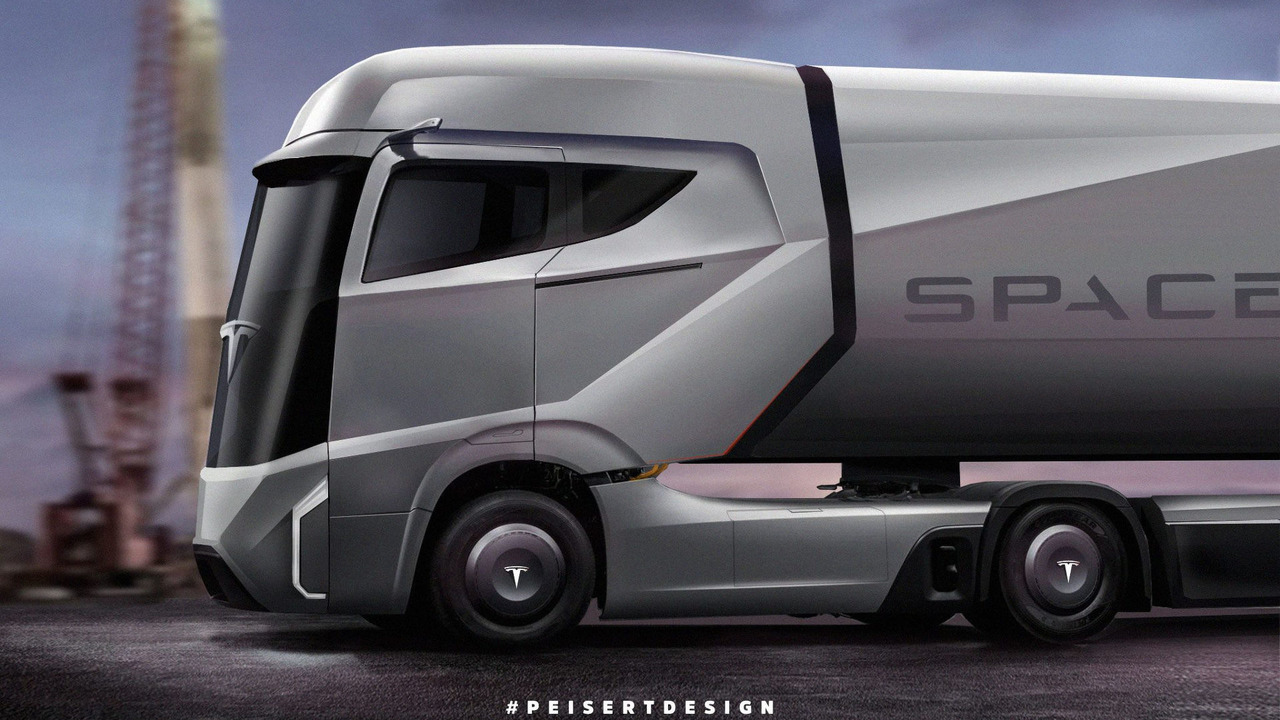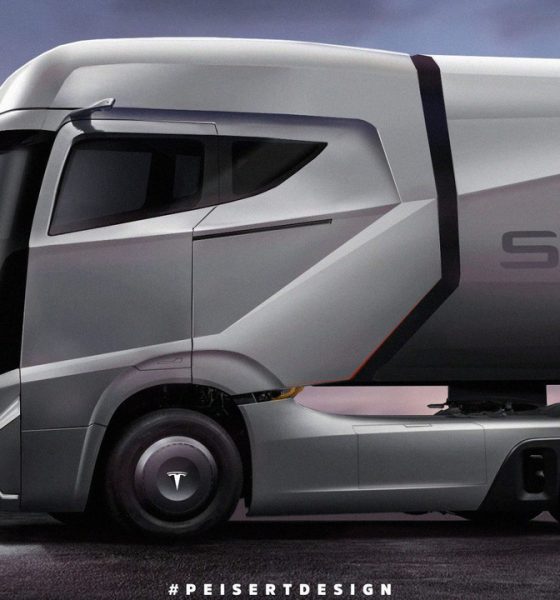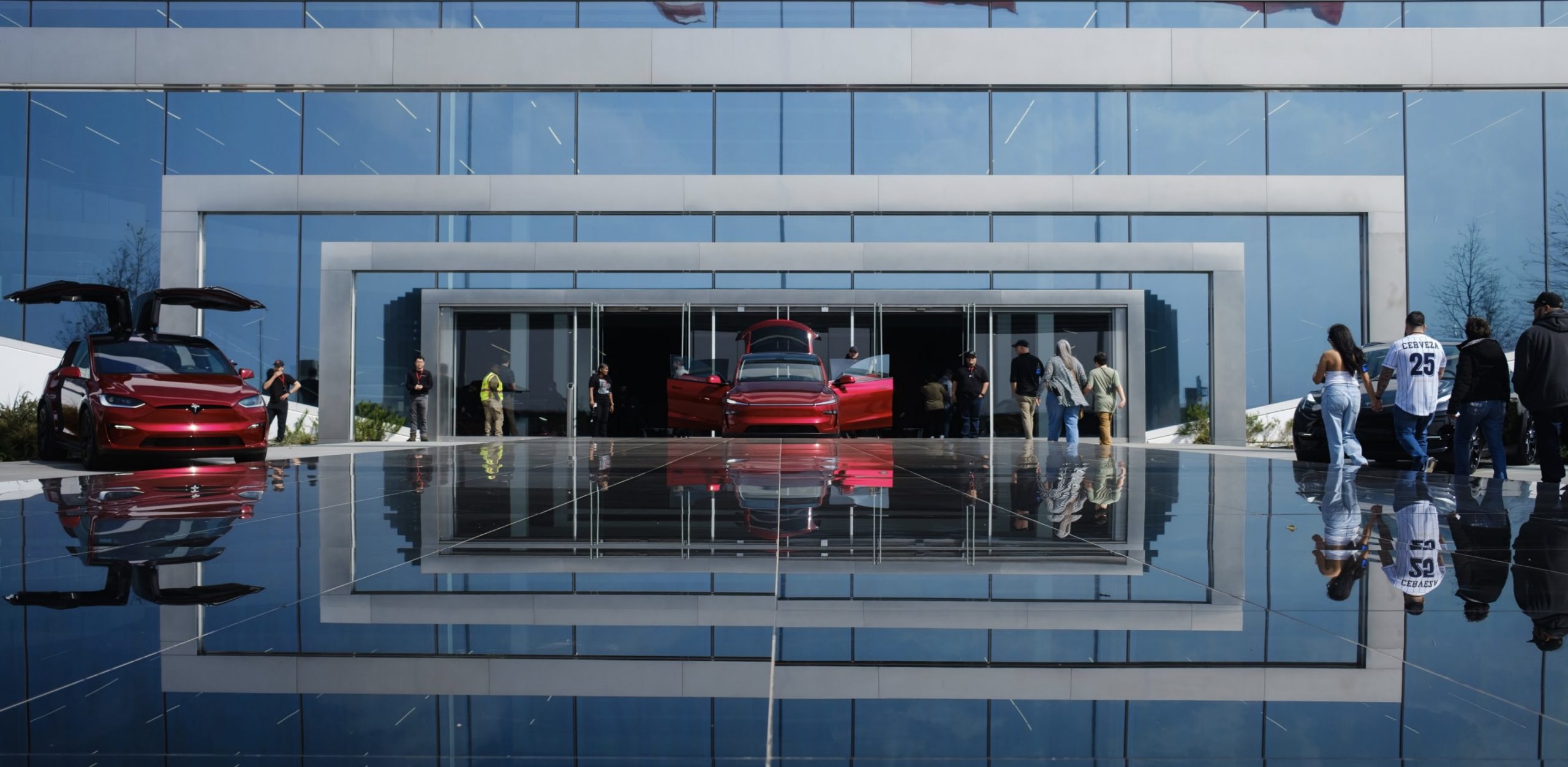

Investor's Corner
Is the trucking industry ready for Tesla? Experts weigh in
When Tesla CEO Elon Musk tweeted that Tesla will unveil an electric semi-truck in September, many in the trucking industry, and even Wall Street, took notice.
Electric vehicles will make up just 1 percent of the entire trucking market by 2020, but the EV trucking industry will grow to 10 percent just a decade later, according IHS Markit, an industry research firm. The percentages of all-electric trucks abroad will be slightly higher, with markets like the European Union, Japan, and China taking the lead.
“There is a certain amount of hype to Tesla’s announcement,” said Antti Lindstrom, an analyst at IHS Markit. “It doesn’t seem that long-distance trucking is ready for electrification right now.”
What will Tesla need to do to create a viable long-haul all-electric trucking industry?
Obstacles that Tesla will need to overcome for all-electric trucking success
Of all the freight transported in America, 70% is transported by the trucking industry, according to Apex Capital. Yet, if Tesla is to break into the trucking industry with all-electric vehicles, it will need to overcome a number of barriers.
Price is probably the number one factor of concern for all-electric long-haul trucks, as an all-electric semi- compared with a diesel truck will likely be much more expensive. “Tesla cars don’t need to prove an economic case to their buyers; Tesla trucks will,” Michael Baudendistel, a Stifel Financial Corp. analyst, wrote in a recent investor report. Yes, Teslas have been targeted thus far to a wealthy segment of the population, but, just as that will change with the introduction of the Model 3, so, too, can Tesla design a reasonably priced big rig when fuel versus charging costs are taken into consideration.
Tesla would have to create a marketplace for electric trucks. “Given the happily consolidated nature of the domestic truck manufacturing market, the prospect of a new competitive threat, from a company with previous success in disrupting established industries nonetheless, is undoubtedly unwelcomed news,” states Baudendistel. This year, however, Mercedes-Benz Trucks is bringing the world´s first all-electric heavy-duty truck to market in a small release. Moreover, Piper Jaffray analyst, Alex Potter, released a note this week revealing that he was downgrading the engine and truck manufacturers Cummins and Paccar — partly as a response to Tesla’s impending semi truck reveal. With Tesla’s proven history, the trucking sector can’t be that far behind for the company. Indeed, as early as 2011, Tesla was invited to testify at the Congressional hearing titled, “The American Energy Initiative.” Tesla spoke then about the need and timing for alternative energy vehicles, especially those powered by electricity. Tesla demonstrated how an entrenched culture like that of the U.S. automaker could be disrupted; trucking manufacturers today have every right to be paying attention.
“We have intentionally departed from the traditional automotive industry model by both focusing exclusively on electric powertrain technology and owning our vehicle sales and service network… If, however, you believe in the power of American innovation to fundamentally change and improve our individual lives and our larger societal interests, then there is no question the time is right to step up and support the development of a viable EV market in the U.S. and to encourage in word and deed the American companies fighting to establish EVs in the marketplace.”
Where would all-electric trucks go for service and repair? “This has been an inconvenience for Tesla cars,” Baudendistel told Trucks.com. “For trucks, though, if the wheels ain’t turnin’, you ain’t earnin’.” Tesla has demonstrated its ability to respond to current owner needs as they became apparent. As early as 2015, the company won an automotive repair satisfaction survey. It launched a Mobile Tire Service program to better serve owners who end up on the side of the road with a flat tire. In anticipation of the Model 3 release, Tesla will be expanding its mobile service capability to include sending technicians to an owner’s home or office for minor repairs. Tesla has the capacity to create a comparable response service and repair program for long-haul all-electric trucks.
The highway charging network for heavy-duty vehicles does not exist; there is no place to charge a long-haul electric truck. “You can’t put the cart before the horse,” Baudendistel said. “Widespread adoption hinges on the availability of fueling stations, and the infrastructure built for Tesla autos was not designed for Class 8 trucks.” Electric trucks currently in use for redistributing cargo require a far smaller range than a long-haul big rig and can be recharged at a central facility. They don’t require a network of charging stations along the nation’s highways. But with the vast Supercharger network that Tesla already has in place, it seems sensible to assume that Tesla would provide adequate comparable charging for fleets of all-electric trucks.
Yes, at this time, recharging electric vehicles is time consuming. “Battery swapping and refueling overnight are both options which would require significant additional investment in infrastructure and logistics,” Baudendistel said. Tesla considered but then discarded the idea of battery swapping with its electric cars. However, with the Electrify America initiative that Volkswagen is spearheading as a result of its diesel malfeasance court settlement, recharging times may drop considerably and quickly as R&D expands. Additionally, unlike an all-electric bus, with its long wheelbase and battery storage underneath, wouldn’t the height and breadth of a semi-truck be the right design for a battery pack that is replaced at a convenient stopping point? Tesla may reconsider battery swapping if the contextual conditions are right.
The trucking industry has expressed concern that batteries needed to power a semi- would be heavy, take up cargo room, and compromise range. Daniel Murray, vice president of research for the American Trucking Research Institute, told Trucks.com, “No one has clarified for us how much extra battery weight will accrue, which, of course, decreases revenue weight.” Baudendistel added, “We believe at least 600-800 miles of range is needed for the truck to be competitive in the line-haul market. We have heard indications that the Tesla semi’s range will be 200-300 miles, which would limit its addressable market.” Just this month, however, Panasonic’s President Kazuhiro Tsuga admitted the battery trade-off between energy density and safety is prodding his company, which partners with Tesla, to look at alternative battery power sources. And this year’s Battery Symposium in Japan, once a showcase for fuel cells and LIB cathode materials, saw a shift to discussions about solid-state, lithium-air, and non-Li-ion batteries. Thus, the current state of batteries for all-electric vehicles may look entirely different in a decade and may fit the needs of Tesla all-electric long haul transportation.
Diesel fuel is inexpensive these days, which limits the costs associated with current big rig transport. “The very low fuel prices we see now and will for a long time are making most alternative-fuel vehicles appear to be very expensive,” Murray said. That perspective may be a bit short-sighted, however, as, in August 2016, the EPA and NHTSA jointly finalized standards for medium- and heavy-duty vehicles through model year 2027. They are intended to improve fuel efficiency, cut carbon pollution, reduce the impacts of climate change, bolster energy security, and spur manufacturing innovation. Clearly, these are comparable goals to Tesla’s as outlined in the 2016 Master Plan Part Deux. Evolution toward all-electric long-haul transportation as spearheaded by Tesla may fulfill many of the upcoming standards so that fossil fuel costs become irrelevant.
Elon Musk as the world’s biggest advocate of electric-powered transportation
Yes, there are many reasons why an all-electric Tesla long-haul truck will be difficult to integrate into the current transportation sector. Then again, as Baudendistel concedes, “If nothing else, Elon Musk—and by extension, Tesla—is a great disrupter.” Tesla’s innovations, from company-owned stores, over-the-air vehicle updates, and autonomous driving features, to name just three, have forced the automotive and technology industries to new levels. So, although many in the trucking industry are skeptical, it has rarely been wise to bet against Elon Musk.
“We are keeping a watchful eye on Tesla as a new entrant,” Baudendistel admits. Even with obstacles to be overcome, he says, “Still, we wouldn’t count Tesla out long-term.”

Investor's Corner
Tesla Q4 delivery numbers are better than they initially look: analyst
The Deepwater Asset Management Managing Partner shared his thoughts in a post on his website.

Longtime Tesla analyst and Deepwater Asset Management Managing Partner Gene Munster has shared his insights on Tesla’s Q4 2025 deliveries. As per the analyst, Tesla’s numbers are actually better than they first appear.
Munster shared his thoughts in a post on his website.
Normalized December Deliveries
Munster noted that Tesla delivered 418k vehicles in the fourth quarter of 2025, slightly below Street expectations of 420k but above the whisper number of 415k. Tesla’s reported 16% year-over-year decline, compared to +7% in September, is largely distorted by the timing of the tax credit expiration, which pulled forward demand.
“Taking a step back, we believe September deliveries pulled forward approximately 55k units that would have otherwise occurred in December or March. For simplicity, we assume the entire pull-forward impacted the December quarter. Under this assumption, September growth would have been down ~5% absent the 55k pull-forward, a Deepwater estimate tied to the credit’s expiration.
“For December deliveries to have declined ~5% year over year would imply total deliveries of roughly 470k. Subtracting the 55k units pulled into September results in an implied December delivery figure of approximately 415k. The reported 418k suggests that, when normalizing for the tax credit timing, quarter-over-quarter growth has been consistently down ~5%. Importantly, this ~5% decline represents an improvement from the ~13% declines seen in both the March and June 2025 quarters.“
Tesla’s United States market share
Munster also estimated that Q4 as a whole might very well show a notable improvement in Tesla’s market share in the United States.
“Over the past couple of years, based on data from Cox Automotive, Tesla has been losing U.S. EV market share, declining to just under 50%. Based on data for October and November, Cox estimates that total U.S. EV sales were down approximately 35%, compared to Tesla’s just reported down 16% for the full quarter. For the first two months of the quarter, Cox reported Tesla market share of roughly a 65% share, up from under 50% in the September quarter.
“While this data excludes December, the quarter as a whole is likely to show a material improvement in Tesla’s U.S. EV market share.“
Elon Musk
Tesla analyst breaks down delivery report: ‘A step in the right direction’
“This will be viewed as better than feared deliveries and a step in the right direction for the Tesla story heading into 2026,” Ives wrote.

Tesla analyst Dan Ives of Wedbush released a new note on Friday morning just after the company released production and delivery figures for Q4 and the full year of 2025, stating that the numbers, while slightly underwhelming, are “better than feared” and as “a step in the right direction.”
Tesla reported production of 434,358 and deliveries of 418,227 for the fourth quarter, while 1,654,667 vehicles were produced and 1,636,129 cars were delivered for the full year.
Tesla releases Q4 and FY 2025 vehicle delivery and production report
Interestingly, the company posted its own consensus figures that were compiled from various firms on its website a few days ago, where expectations were set at 1,640,752 cars for the year. Tesla fell about 4,000 units short of that. One of the areas where Tesla excelled was energy deployments, which totaled 46.7 GWh for the year.
🚨 Wedbush’s Dan Ives has released a new note on Tesla $TSLA:
“Tesla announced its FY4Q25 delivery numbers this morning coming in at 418.2k vehicles slightly below the company’s consensus delivery estimate of 422.9k but much better than the whisper numbers of ~410k as the…
— TESLARATI (@Teslarati) January 2, 2026
In terms of vehicle deliveries, Ives writes that Tesla certainly has some things to work through if it wants to return to growth in that aspect, especially with the loss of the $7,500 tax credit in the U.S. and “continuous headwinds” for the company in Europe.
However, Ives also believes that, given the delivery numbers, which were on par with expectations, Tesla is positioned well for a strong 2026, especially with its AI focus, Robotaxi and Cybercab development, and energy:
“This will be viewed as better than feared deliveries and a step in the right direction for the Tesla story heading into 2026. We look forward to hearing more at the company’s 4Q25 call on January 28th. AI Valuation – The Focus Throughout 2026. We believe Tesla could reach a $2 trillion market cap over the coming year and, in a bull case scenario, $3 trillion by the end of 2026…as full-scale volume production begins with the autonomous and robotics roadmap…The company has started to test the all-important Cybercab in Austin over the past few weeks, which is an incremental step towards launching in 2026 with important volume production of Cybercabs starting in April/May, which remains the golden goose in unlocking TSLA’s AI valuation.”
It’s no secret that for the past several years, Tesla’s vehicle delivery numbers have been the main focus of investors and analysts have looked at them as an indicator of company health to a certain extent. The problem with that narrative in 2025 and 2026 is that Tesla is now focusing more on the deployment of Full Self-Driving, its Optimus project, AI development, and Cybercab.
While vehicle deliveries still hold importance, it is more crucial to note that Tesla’s overall environment as a business relies on much more than just how many cars are purchased. That metric, to a certain extent, is fading in importance in the grand scheme of things, but it will never totally disappear.
Ives and Wedbush maintained their $600 price target and an ‘Outperform’ rating on the stock.
Investor's Corner
Tesla releases Q4 and FY 2025 vehicle delivery and production report
Deliveries stood at 406,585 Model 3/Y and 11,642 other models, for a total of 418,227 vehicles.

Tesla (NASDAQ:TSLA) has reported its Q4 2025 production and deliveries, with 418,227 vehicles delivered and 434,358 produced worldwide. Energy storage deployments hit a quarterly record at 14.2 GWh.
Tesla’s Q4 and FY 2025 results were posted on Friday, January 2, 2026.
Q4 2025 production and deliveries
In Q4 2025, Tesla produced 422,652 Model 3/Y units and 11,706 other models, which are comprised of the Model S, Model X, and the Cybertruck, for a total of 434,358 vehicles. Deliveries stood at 406,585 Model 3/Y and 11,642 other models, for a total of 418,227 vehicles.
Energy deployments reached 14.2 GWh, a new record. Similar to other reports, Tesla posted a company thanked customers, employees, suppliers, shareholders, and supporters for its fourth quarter results.
In comparison, analysts included in Tesla’s company-compiled consensus estimate that Tesla would deliver 422,850 vehicles and deploy 13.4 GWh of battery storage systems in Q4 2025.
Tesla’s Full Year 2025 results
For the full year, Tesla produced a total of 1,654,667 vehicles, comprised of 1,600,767 Model Y/3 and 53,900 other models. Tesla also delivered 1,636,129 vehicles in FY 2025, comprised of 1,585,279 Model Y/3 and 50,850 other models. Energy deployments totaled 46.7 GWh over the year.
In comparison, analysts included in Tesla’s company-compiled consensus expected the company to deliver a total of 1,640,752 vehicles for full year 2025. Analysts also expected Tesla’s energy division to deploy a total of 45.9 GWh during the year.
Tesla will post its financial results for the fourth quarter of 2025 after market close on Wednesday, January 28, 2026. The company’s Q4 and FY 2025 earnings call is expected to be held on the same day at 4:30 p.m. Central Time.








